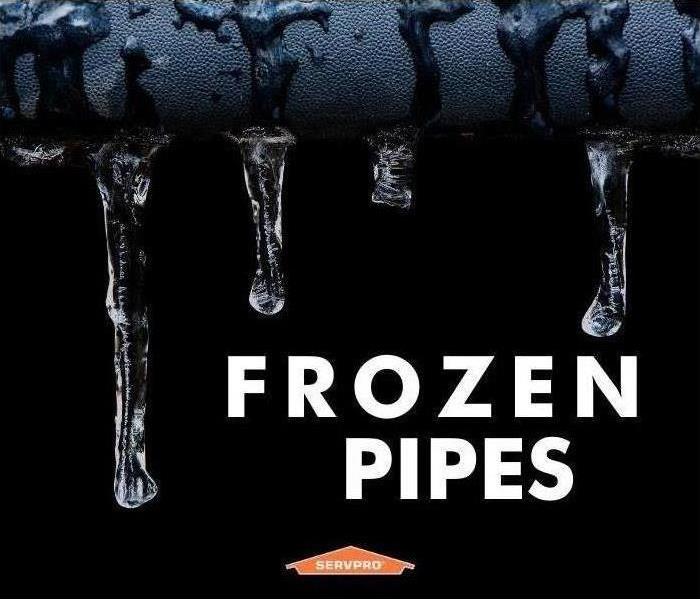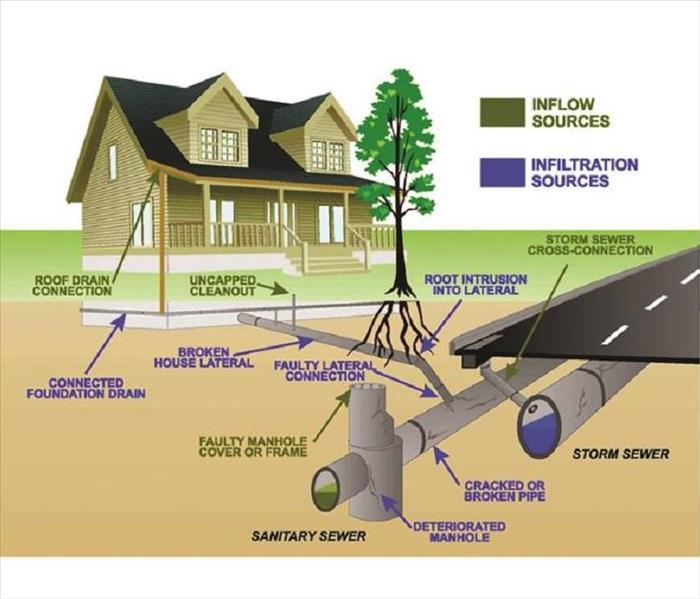Recent Storm Damage Posts
How to Deal With Frozen Pipes in Winter Weather | SERVPRO of Overland/Cool Valley
1/31/2024 (Permalink)
 Frozen pipes? Call SERVPRO of Overland/Cool Valley
Frozen pipes? Call SERVPRO of Overland/Cool Valley
At SERVPRO of Overland/Cool Valley, we often see an increase in water losses during the winter. A major culprit of these losses are frozen pipes.
When the water inside the pipes freeze, its molecules expand, which causes a blockage of ice that prevents unfrozen water from passing through. When the frozen pipe begins to thaw, the pressure from the water can cause the pipe to burst.
How Can I Tell My Pipes Are Frozen?
One of the most common signs that you are dealing with frozen pipes is when you turn on your faucet and no water comes out (similarly, if you flush your toilet and it doesn’t refill). If this happens, you should check your water source to make sure it’s still turned on and that a leak isn’t occurring.
Another tell-tale sign of frozen pipes is when your water line is coated in frost or is bulging.
If you know that your pipes are frozen, you can either choose to address the issue yourself or call in professionals.
How to Prevent Frozen Pipes
Frozen pipes cause an estimated $400-$500 million in damage annually. To avoid adding to that total, there are several steps you can take.
When the weather gets cold, you should drain water from pipes that are likely to freeze, such as sprinkler and swimming pool water supply lines. Outside hoses should also be disconnected and drained, and indoor valves supplying these access points must be closed.
On frigid days, let your faucets drip cold water. Having the water drip out will make it harder for the water in the pipes to freeze. Your thermostat should also be kept around the same temperature at all times, and your house temperature should never fall below 55 degrees. Garage doors should also be kept shut to protect water lines.
If you are worried about your pipes freezing, you can also place a 60-watt bulb in the areas you’re concerned with. Just make sure none of the materials near the bulb are combustible.
What If My Pipes Are Already Frozen?
If you realize your pipes have frozen, the first step is to keep your faucet open. This will help with thawing and allow for moving water to flow through the pipe.
You can also apply heat to the specific area of the pipe that is frozen. You can do this by wrapping an electronic heating pad around the pipe or heating the area with a hair dryer. Using towels soaked in hot water can help, too.
Keep applying heat until water flow returns to normal. After the pipe has been thawed, turn on other faucets around the house to make sure you don’t have any more frozen pipes.
If the pipe is inside an exterior wall, you should immediately call a professional contractor. It is likely that a hole will need to be cut in the wall toward the inside of the house to allow the pipes to be exposed to warmer air.
Frozen pipes can be a catastrophic problem for your home, but taking proactive measures can help you address the problem before it even starts.
Sewer Lines
5/7/2020 (Permalink)
A Guide to Your Private Sewer Line
What is a lateral line?
The lateral line connects your home or building to the public sewer system. Wastewater from your sinks, showers, toilets, dishwashers and washing machines flows through the lateral line to the public sewer system.
Who is responsible for maintaining and repairing the lateral line?
The lateral line, including connection, is private property. It is the property owners’ responsibility to maintain and repair the lateral line.
It’s important to keep the lateral line clear of obstructions and in good repair. This will greatly reduce the risk of blockages, clogs and water backups.
What causes lateral lines to become blocked or obstructed?
Lateral lines can be blocked or obstructed by items flushed down the toilet or washed down the drain, as well as tree roots, grease, and other obstructions.
How do I know if my lateral line is blocked or damaged?
Some signs that your lateral is blocked or damaged include slow draining, water pooling around the basement floor drains, sewage smell inside or outside the building, wastewater leaking from cleanouts, and wet ground in your yard.
Will insurance cover repairs to the lateral line?
Most homeowners’/business owners’ insurance policies do not cover damages caused by a problem with the lateral line. You should verify coverage with your insurance agent.
Many area municipalities offer lateral line insurance for their residents. This insurance helps offset the cost of repairing lateral lines. Please verify all information by contacting your municipality.
How do I get the lateral line repaired?
If you do not qualify for a municipal lateral line insurance program, then you should contact a licensed professional plumber.
How do I maintain the lateral line?
• Have the lateral line inspected and cleaned annually by a licensed plumber.
• Do not plant trees or large shrubs near the lateral line. Roots can enter the lateral line and cause a blockage. If roots enter your lateral line, call a license plumber to clear the line.
• Do not pour grease down the sink. When grease cools, it can build up in the lateral line and cause a blockage.
• Do not flush diapers, feminine hygiene products or other non toilet paper materials down the toilet. These items can block the lateral line.
• In some areas, downspouts are connected to the lateral line. Debris from the roof can wash into the gutters and eventually reach the lateral line. Keep gutters clean to keep debris from blocking the lateral line.
• Repair or replace damaged lateral lines as soon as possible.
If your home or business experiences water damage we are always here to help at SERVPRO of Overland/Cool Valley 314-279-5600.
Xtreme Heat
5/6/2020 (Permalink)
As summer approaches, it is time to consider safety precautions for extreme heat in the coming months. Heat affects all people, but especially the young, elderly, sick and overweight. According to the EPA, "the sun can heat dry, exposed urban surfaces, such as roofs and pavement, to temperatures 50-90 degree hotter than the air, while shaded or moist surfaces-often in more rural surroundings-remain close to air temperatures."
If you must go outside, wear loose-fitting, light-colored clothing, and be sure to apply sunscreen often. Pay attention to signs of heat exhaustion, which are heavy sweating; weakness; cold, pale and clammy skin; nausea or vomiting; and fainting according to the Center for Disease Control and Prevention (CDC). Heat exhaustion can lead to heat stroke, which is life-threatening. Signs of heat stroke are a high body temperature (103+), rapid and strong pulse, and possible unconsciousness. If you think someone has heat stroke, call 911 immediately and move the person somewhere cool.
Extreme heat is a serious danger. For more information on preparation and prevention, visit ready.gov or cdc.gov.



 24/7 Emergency Service
24/7 Emergency Service


